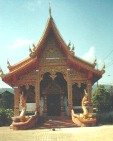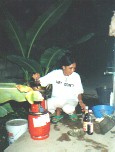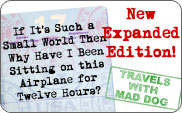| HOME Doggy Style Archive On the Road Holidays Doggy Style Blog Novel |

|

|
Now
get 53 of Mad Dog's travel columns Read more Mad Dog on the Road! It’s
a Thai Score by Mad Dog |
||
The phrase asking about the bathroom was too long for me to remember— not to mention that if I used high tones when I should have used falling ones I might accidentally end up asking for a date with their father—so I didn’t worry about it. |
It’s
a 10-hour bus ride from Bangkok to Chiang Mai. That’s a long time to watch
roadside Thailand zip by, ponder why they showed a video as soon as we
pulled out of Bangkok and then left the screen blank for the next 8½ hours,
regret that we didn’t pass The World’s Largest Bamboo Toothpick or the
Sticky Rice Sculpture Museum, and talk to Kim.
Kim was sitting next to me because the bus hostess—kind of a rolling
flight attendant—told us to sit next to each other, this in spite of the
fact that at the time we were the only two people on the bus. And would be
until it made three more stops in Bangkok trolling for passengers. But it
turned out good. We kept each other company, neither of us drooled when we
napped (or at least she was nice enough not to mention it), and we hung out
a couple of times in Chiang Mai.
The trip also gave me time to look through the guide book and learn a little
of the Thai language. The sad truth is foreign languages don’t come easy
for me. My memory’s so badly tuned that new words go in correctly and come
out like a dyslexic word jumble. So whenever I’m in a new country I focus
on the essentials: please, thank you, hello, goodbye, and where’s the
bathroom.
Thai is tricky. Like many Asian languages they not only use sounds that
don’t exist in English, but the same word can mean different things
depending on whether it’s pronounced with a middle tone, low tone, high
tone, falling tone, or rising tone. Whatever that means. They all sound the
same to my farang ears. Buddha help a tone-deaf Thai person because
they might as well not have ears at all for all the words they’ll
understand.
|
|
|
The oddest thing I ate was fried worms. Or maybe they were grubs. It was hard to tell since the girl selling them didn’t speak any English—not even numbers to tell me how much they cost. |
The
last important phrase I learned was mai pen rai, which means “no
problem.” Think c’est la vie, que sera sera, and
“I’m here for four days, so what’s a few hours’ wait if it will
help maintain international relations.”
[NOTE: These are phonetic spellings. The written Thai language is
indecipherable to the untrained eye, and lord knows I’ve been called
untrainable by more than one person, so I’m sticking with phonetics.]
Language is more difficult for the traveler. We have to learn at least
some of each country’s language while the natives can focus on English,
since so many tourists speak at least a little bit of it. Interestingly,
the first thing most natives learn is numbers. It’s amazing how many
places you go where people can’t say hello in English but can tell you
how much something costs. *
* *
* * *
*
Chiang Mai is Thailand’s second largest city, having a population of
250,000, or about 4% as many as the largest city, which is Bangkok.
The only traffic jams are on Saturday afternoon when families flock to the
arboretum, zoo, and waterfalls to relax. The city has 300 wats
(temples), almost as many as Bangkok, but in a much smaller area. The tuk-tuk
drivers are cool and have that mai pen rai attitude, having all
failed the BAT, the Bangkok Aggression Test. It’s walkable, cool at
night, and has a pumpkin-shaped house nestled in the hills outside the
city. What more could you want?
How about a Thai massage? These are famous, and I had to try one. Especially since I have a feeling the ones I see advertised in the Tenderloin area of San Francisco aren’t as innocuous as they’re supposed to be. Maybe as therapeutic, but in an entirely different way.
|
|
|
Possibly the best thing I learned during my stay in Bali—aside from the fact that geckos take a crap in the same place every day—is how to drive a motorbike. I tooled around the hills outside Chiang Mai. |
But that won’t pose a problem since finding good food in Chiang Mai is a
breeze. Food vendors, markets, and restaurants are everywhere. I ate sate,
red curry, green curry, pad Thai, tom yam (spicy soup), lots
of sticky rice, and things I couldn’t identify. I stayed away from the
Pizza Hut, McDonalds, and German restaurant that had a Thai hostess
wearing a traditional German peasant costume. What can I say, schnitzel in
sweet yellow curry just didn’t sound good that night.
The oddest thing I ate was fried worms. Or maybe they were grubs. It was
hard to tell since the girl selling them didn’t speak any English—not
even numbers to tell me how much they cost. I looked at them sitting in
the tray. And yes, they were already cooked. She smiled. I smiled back.
She scooped a few up in a spoon and offered them to me. They didn’t
taste like much, but they were crunchy, like a good snack food that just
needed a little salt, a flashy package, a catchy name like Crispy Critters™,
and an advertising mascot named Gary Grub to make it big.
I asked her if my trying them meant “Survivor” would be sending me a
big fat check for a million baht, but I’m not sure if she
understood since my Thai is only three words better than her English. But
I’m pretty sure she told me I’d clinch it if I took my shirt off and
paraded around the market, so I did. It turns out the Chiang Mai police
are very nice. I guess they’re used to farang.
There
was an elephant camp, a snake farm, a monkey school, and a buffalo camp.
It seems the Thais love wild animals, they just don’t love them that
wild. I also visited a hill-tribe village. |
|
|
There are a lot of Westerners in Chiang Mai. In some parts of town they outflank the Thais by 10 to 1. But it’s easy to wander the small streets and alleys and not see a single one for, oh, eight minutes at a stretch. |
Hill-tribes are scattered throughout northern Thailand. There are a number
of them around Chiang Mai, mostly Hmong, a tribe that wandered out of
southern China a couple of hundred years ago and ended up in Thailand. To
this day they wish they’d renewed their AAA membership so they could
have gotten a decent map. Over the years they’ve retained their
time-honored traditions, attitudes, clothing, and way of life. Well, as
long as you assume that two hundred years ago they were hawking souvenirs,
charging to see a one-room museum, and wearing beautifully embroidered
costumes while posing for cheesy photographs. For money, of course.
You can’t blame them. After all, they were pressured by the government
to abandon their traditional livelihood: tourist hunting. Just kidding.
Actually they used to grow opium poppies which is frowned upon these days.
Thus they were encouraged to stop planting pretty flowers and instead open
their villages to tourists. Now every other storefront in Chiang Mai
offers treks to see them, so van after van rumbles down the bumpy dirt
roads to check them out. At least we can be thankful no one’s thought of
opening HmongousLand. Yet. *
* *
* * *
*
There are a lot of Westerners in Chiang Mai. In some parts of town they
outflank the Thais by 10 to 1. But it’s easy to wander the small streets
and alleys and not see a single one for, oh, eight minutes at a stretch.
It’s simple to identify them—when they’re not taking photographs
they’re writing in their journal. Couples were doing it on the bus to
Chiang Mai. Groups sat in restaurants having dinner, each person
scribbling away instead of talking or eating. And they were sitting on
benches, writing away when they should have been looking at the gorgeous
temple in front of them. What will they do with all these journals, invite
their friends over and make them sit and read every word? It makes a slide
presentation sound absolutely heavenly. |
|
|
There was the restaurant that claimed to have “your flavarite food,” a line any ad agency in the world would be proud to have come up with. And there was the dental clinic that boasted it was “full time.” Scary to think what those part time clinics do with the other half of their day. |
I started to get worried since I don’t keep a journal. Do they
know something I don’t? Did I miss the page in the guide book that said
immigration checks for it on the way out of the country?
“Ticket, passport, and journal.”
“I don’t have a journal.”
“No journal? That will be twenty days, twenty thousand baht, or
twenty peppers eaten at once.”
It’s a good thing this isn’t Singapore or I’d really be in trouble. *
* *
* * *
*
A lot of non-Americans were wearing shirts trumpeting American
universities. This is pretty universal. I started stopping
them—Westerners and Thais alike— and asking if they went to Harvard,
Yale, Texas A&M, or whatever school their shirt was from. If they
understood me, of course they said no. I told them I did, then added that
I thought it was great that they proudly displayed my school’s logo. If
they ever get to talking among themselves I’ll be known as the most
educated man in all of Asia.
I had my fortune told in a temple, but since the paper I was handed was
printed in Thai and Chinese I have no clue what’s in store for me. I saw
muay Thai (Thai boxing) which was preceded by a cabaret show that
included a Cyndi Lauper imitator. I fought my way through the night
bazaar, wandered around the Sompet market where I could only identify 1
out of 100 food items and randomly tried a few that didn’t look like
grubs, and I had some pretty respectable croissants at J.J.’s Bakery.
Not very Thai, but c’est la....I mean, mai pen rai, you
know. Part I - Hijacked by a tuk-tuk driver ©2001 Mad Dog
Productions, Inc. All Rights Reserved. |
|
|
|||
|
|
 They do make it easy with sawatdee, which means hello, goodbye, good
morning, good afternoon, good evening, and good night. It’s the Thai aloha.
I added kor and kob khun to my vocabulary, but the phrase
asking about the bathroom was too long for me to remember—not to mention
that if I used high tones when I should have used falling ones I might
accidentally end up asking for a date with their father—so I didn’t
worry about it. I figured if I stood knock-kneed and jiggled around a lot
they’d either point me in the right direction or give me Ritalin. Either
way I’d be fine.
They do make it easy with sawatdee, which means hello, goodbye, good
morning, good afternoon, good evening, and good night. It’s the Thai aloha.
I added kor and kob khun to my vocabulary, but the phrase
asking about the bathroom was too long for me to remember—not to mention
that if I used high tones when I should have used falling ones I might
accidentally end up asking for a date with their father—so I didn’t
worry about it. I figured if I stood knock-kneed and jiggled around a lot
they’d either point me in the right direction or give me Ritalin. Either
way I’d be fine.
 I rented a motorbike, which is definitely the way to go. Possibly the best
thing I learned during my stay in Bali—aside from the fact that geckos
take a crap in the same place every day—is how to drive a motorbike. I
tooled around the hills outside Chiang Mai, stopping at beautiful temples,
glorious vistas, waterfalls which Thai people can visit for 20 baht
while us farang pay 200, a house shaped like a pumpkin, and the
King and Queen’s arrival at their palace by helicopter. The last stop
wasn’t entirely voluntary—the army troops standing in the middle of
the road made sure I stopped.
I rented a motorbike, which is definitely the way to go. Possibly the best
thing I learned during my stay in Bali—aside from the fact that geckos
take a crap in the same place every day—is how to drive a motorbike. I
tooled around the hills outside Chiang Mai, stopping at beautiful temples,
glorious vistas, waterfalls which Thai people can visit for 20 baht
while us farang pay 200, a house shaped like a pumpkin, and the
King and Queen’s arrival at their palace by helicopter. The last stop
wasn’t entirely voluntary—the army troops standing in the middle of
the road made sure I stopped. I enjoyed the signs. There was the restaurant that claimed to have “your
flavarite food,” a line any ad agency in the world would be proud to
have come up with. Then there was the dental clinic that boasted it was
“full time.” Scary to think what those part time clinics do with the
other half of their day. There was a sign in the bathroom at Wat Doi
Suthep which read “Please don’t go up to the sanitary with feet.”
And there was another temple that, instead of having a donation box for
poor people as most did, had one that asked to “Please donate to the
poor dogs.” I dropped in some money, even though there was no assurance
that my hard earned bahts wouldn’t be subsidizing some pampered
Pekinese’s diet of pad Thai flavored Alpo.
I enjoyed the signs. There was the restaurant that claimed to have “your
flavarite food,” a line any ad agency in the world would be proud to
have come up with. Then there was the dental clinic that boasted it was
“full time.” Scary to think what those part time clinics do with the
other half of their day. There was a sign in the bathroom at Wat Doi
Suthep which read “Please don’t go up to the sanitary with feet.”
And there was another temple that, instead of having a donation box for
poor people as most did, had one that asked to “Please donate to the
poor dogs.” I dropped in some money, even though there was no assurance
that my hard earned bahts wouldn’t be subsidizing some pampered
Pekinese’s diet of pad Thai flavored Alpo.
